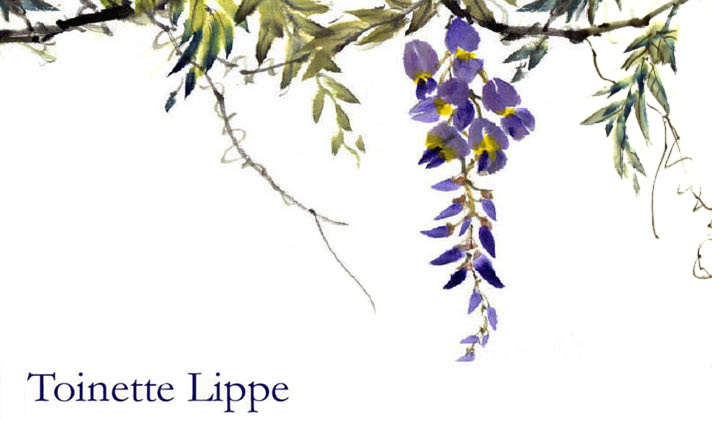
The Way of the Brush
 In 2000, on the day my son started work, I felt that I had paid my dues to society and I quit my full-time job. I continued, free-lance, as editorial director of Bell Tower, the spiritual imprint I had founded in 1989, and began to explore other things life had to offer. Until that moment, work had consumed me and I wanted to discover how to play, something that had eluded me for far too long. At sixty-one, it was a little late to begin playing but I thought it worth a try. I also wanted to see if I could get the right side of my brain to work. I knew that unless I was willing to make a major shift, I would just keep putting one foot in front of the other, working harder and harder, until my life was over.
In 2000, on the day my son started work, I felt that I had paid my dues to society and I quit my full-time job. I continued, free-lance, as editorial director of Bell Tower, the spiritual imprint I had founded in 1989, and began to explore other things life had to offer. Until that moment, work had consumed me and I wanted to discover how to play, something that had eluded me for far too long. At sixty-one, it was a little late to begin playing but I thought it worth a try. I also wanted to see if I could get the right side of my brain to work. I knew that unless I was willing to make a major shift, I would just keep putting one foot in front of the other, working harder and harder, until my life was over.
After I edited a best-selling translation of Lao Tsu’s Tao Te Ching in the early 1970s, friends began to give me not only rice paper, brushes, ink stones, and sticks of red and black ink, but also books on Chinese art. I never asked for any of this but many people seemed convinced that I would enjoy brush painting. All these things remained on my shelf until about six months after I had abandoned the daily corporate grind. Then one day, I happened to pass a small storefront on Houston Street that bore a sign reading “Koho School of Sumi-e,” I picked up a brochure from the rack outside, and a week later began my apprenticeship.
I had no art training and learning the time-honored craft of East Asian brush painting has been a long and thorny road. It took me six years to see that the greatest obstacle I faced was that I had spent my life trying to control the outcome of everything I did. But art is uncontrollable. The muse is not on call. Each day it is necessary for me to be here, brush in hand, in case this is the day she decides to visit. I realized that I had made a mistake in wanting to discover “if I could get the right side of my brain to work.” I should have been exploring whether it knew how to play, not how to work. Because I’m trying to get the brush strokes “right,” it still feels like work and I’m aware that until I stop treating everything I do as work rather than play, I’m unlikely to enjoy any of it. What I’m hoping is that my “works on paper” will soon be transformed into “plays on paper.”
“What I have not drawn, I have never really seen,” wrote Frederick Franck in his wonderful book The Zen of Seeing. “Once you start drawing an ordinary thing, a fly, a flower, a face, you realize how extraordinary it is—a sheer miracle.” We all think we know what a lettuce looks like but it's only when you begin to draw one that you discover “what makes a lettuce a lettuce rather than a curly kale.” This is also true of painting, so before I pick up the brush I study whatever it is I plan to paint. I want to understand its form and nature and feel it inside me before I attempt to capture it on paper.
The spontaneous style of East Asian brush painting seeks to express the essence of something with a few swift and sure strokes. Ancient Chinese masters described it as allowing “the brush to dance and the ink to sing” and contemporary Sumi-e artist Motoi Oi says: “The aim is not the reproduction of the subject matter but the elimination of the inessential” or, to put it another way, the painter seeks to distill nature rather than record it. My hope is that the image will be intense and potent, that it will leap off the paper and into the viewer’s heart. The painting comes alive in proportion to how present I am and how lightly I hold the brush. As Kaz Tanahashi taught me, two principles must be kept in mind: “Undivided attention equals unswerving strokes” and “Do not hold a brush unless you are smiling.”
I bow to all my teachers—Koho Yamamoto, Zhang Zhan, Mildred Gallo, Charles Chu, Jong Wang Lee, Wanxin Zhang, Kaz Tanahashi, and Sungsook Setton—each of whom has guided me in different but essential ways along the path.
I hope that one day my brush will express the luminous purity of Mary Oliver’s poems, the vitality of Paul Reps’ Zen telegrams (minimalist paintings of a “cucumber unaccountably cucumbering,” “consciousness delighting as crane,” and other small miracles), the exuberant love of life in Pablo Neruda’s odes, and the transcendence of Ralph Vaughan Williams’ orchestral piece, “The Lark Ascending.” I yearn to experience wonder, joy, and delight as I paint and to express these qualities in such a way that others may experience them too.